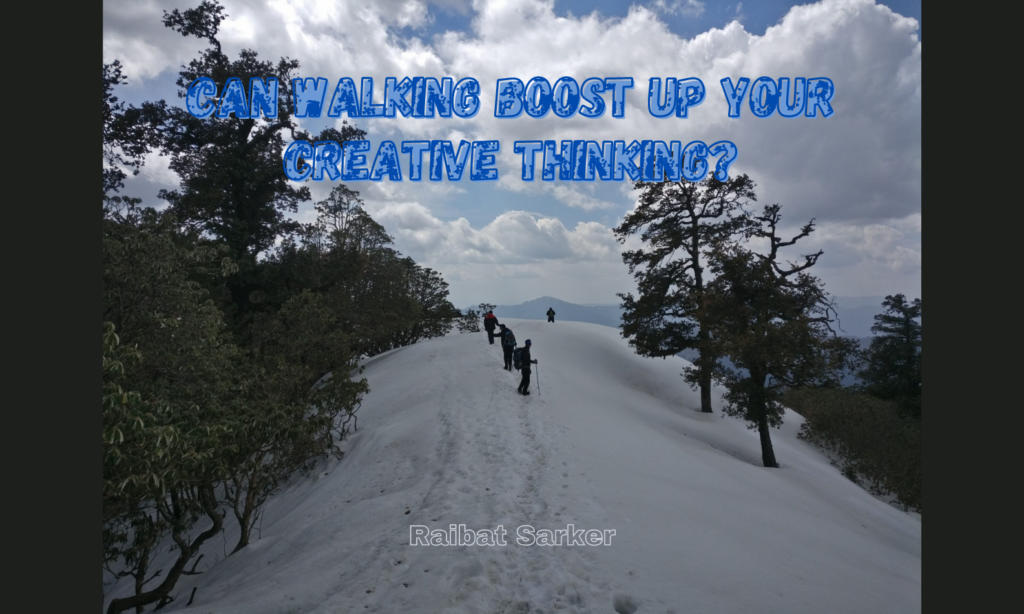
“All truly great thoughts are conceived while walking.”
― Friedrich Nietzsche.
It was during one of the many webinars I attended last year that a panelist popped up this concept of correlating walks and improving creativity. As someone who enjoys trekking and taking long walks, this instantly felt like an intriguing thought process. But on reading a bit on the theme, I found out that this idea/concept has been in practice since a long time!
The History
Throughout history, there are countless examples of creative people who had ‘walking’ as an important part of their daily routine. Nikolas Tesla, for instance, is known to ideate many of his inventions during his daily strolls in the park. In 1882, while on a walk, he came up with the concept for a brushless AC motor, sketching the first drafts of its rotating electromagnets in the sand of the path! Also, writers and poets like Charles Dickens and William Wordsworth were known to be avid walkers. In an article from 1839 entitled Recollections of the Lakes and the Lake Poets, the writer Thomas De noted that “…upon good data, that with these identical legs Wordsworth must have traversed a distance of 175,000 to 180,000 English miles!”
In fact, many authors have claimed walking to be the perfect anecdote to writer’s block. There are several examples of highly successful people who have used walking to their advantage! Steve Jobs was famous for conducting walking meetings. Mark Zuckerberg has also emulated this idea of holding meetings on foot. But all of this definitely warrants the question if there is a scientific explanation to back this up. What exactly about walking stimulates the creativity cells in us?
Recent Findings
Well, a 2014 study from Stanford University says that the idea definitely holds water! Marily Oppezzo and Daniel L. Schwartz from Stanford conducted a study that demonstrates that walking does improve creative ideation in real-time and shortly after. The study comprised 4 experiments that presented the participants (mostly students) with various tasks involving convergent and divergent thinking carried out in different scenarios of walking and sitting. Divergent thinking is a thought process or method used to generate creative ideas by exploring many possible solutions whereas Convergent thinking deals with the ability to answer standard questions “correctly” which do not require much creative brainstorming.
The first experiment involved the participants completing the standard Guilford’s Alternate Uses (GAU) Test of creative divergent thinking and Compound Remote Associates Test (CRA) test of convergent thinking while being seated and then when walking on a treadmill. The results were interesting: walking caused a 60% improvement in creativity! But there was a concern regarding the method. Since walking always followed sitting, there remained a possibility that the better results could just be an outcome of practice and not walking itself! Further experiments ruled out this possibility that practice could tamper with the results. Walking also exhibited a residual effect in further experiments where the seated creativity was more when it was preceded by walking than those participants who had not walked at all!
The study had a very interesting observation. It showed that it was the act of walking that boosted the creative response and not the environment, that is, there was an increase in creative output irrespective of whether the act of walking was carried out on a treadmill or outside.
The 4th experiment was slightly different. It evaluated the creative output based on the participant’s ability to create analogies based on some given prompts. Here too, walking led to an improved analogical creativity!
But there’s one thing that has to be kept in mind. Even though the study showed that walking promoted creative thinking, it did not have a positive impact on the kind of focused thought process required for single, correct answers.
The Explanation
Now, what’s the explanation behind this effect of walking? Why does walking affect creative brainstorming? It is not exactly known. Researchers have theories regarding how the act of walking influences the parts of the brain. One plausible explanation is, “There are the proximal cognitive mechanisms that produce greater creativity. Walking had a strong influence on the expression of associative memory. People presented more ideas, and the ideas tapped each person’s unique associative network, which led to an increase in novelty compared with other people’s ideas.” Needless to say, there’s a great amount of research going on in this regard and surely the mysteries surrounding the brain would become clearer.
For the time being, if you’re ever stuck or have run out of ideas, try leaving your desk and take yourself out for a stroll!
References:
- https://theconversation.com/walking-with-wordsworth-on-his-250th-birthday-135474
- https://www.canva.com/learn/taking-long-walks/
- Journal of Experimental Psychology:Learning, Memory, and Cognition 2014, Vol. 40, No. 4, 1142–1152.
- https://www.thegreatcoursesdaily.com/out-of-ideas-take-a-walk-stimulate-your-creativity-with-a-stroll/
About the Author:

Raibat is a 4th-year Integrated MS student at the Department of Chemistry, IISER Bhopal and a KVPY fellow. Apart from being a big foodie and FCB fan, he loves trekking and camping. When he’s not sciencing, eating, or complaining about his bad luck, you will find him hooked into novels or planning his next trek! Also, he is associated with The Qrius Rhino.
Other articles by the author that you may find interesting:
- The Reason Behind Earth’s perfume!
- SOLAR POWERED SEA SLUGS!
- Something Interesting and Bizarre about Stick Insects!
- Memory transfer between two organisms! YES, you read that right!
- The Doorway Effect!
- Metals vs Microbes- the Oligodynamic Effect!
- Does hot water freeze faster than cold water? The Mpemba Effect!
- Should DHMO be banned?- The DHMO Parody!
- “The Most Wonderful Plant in the World”